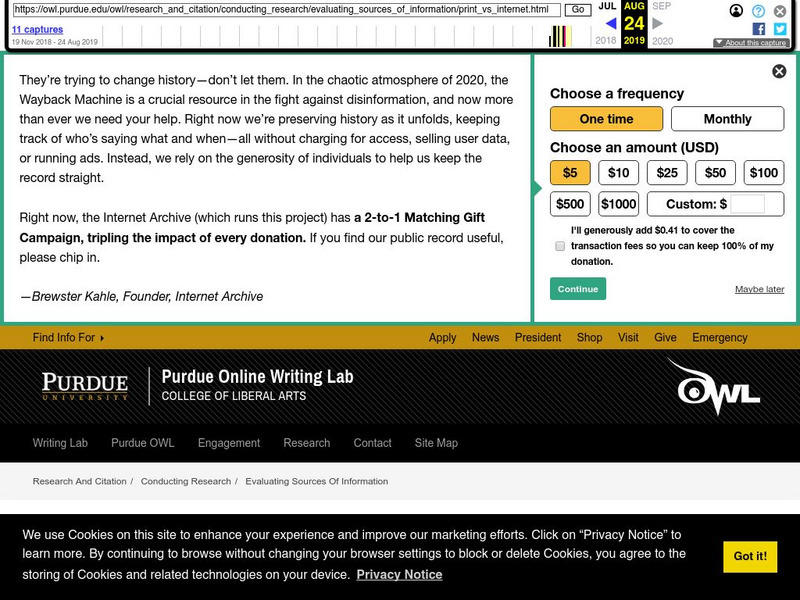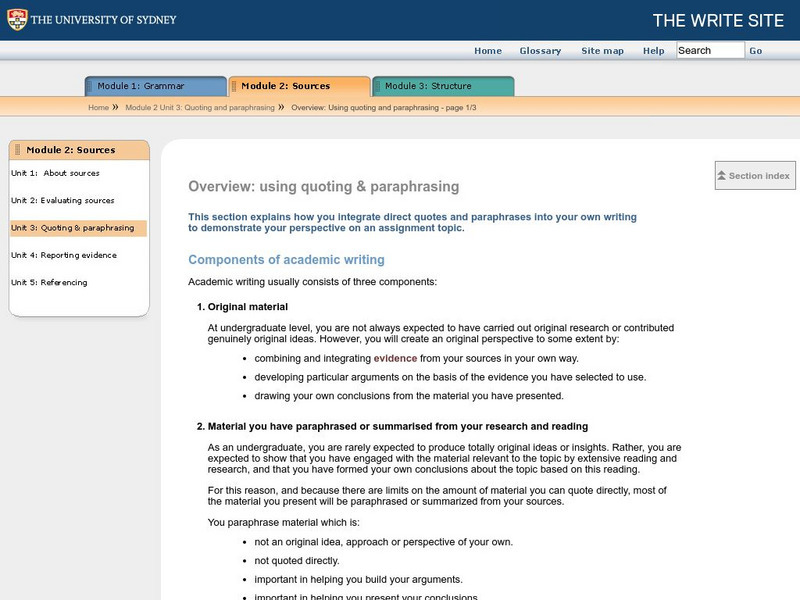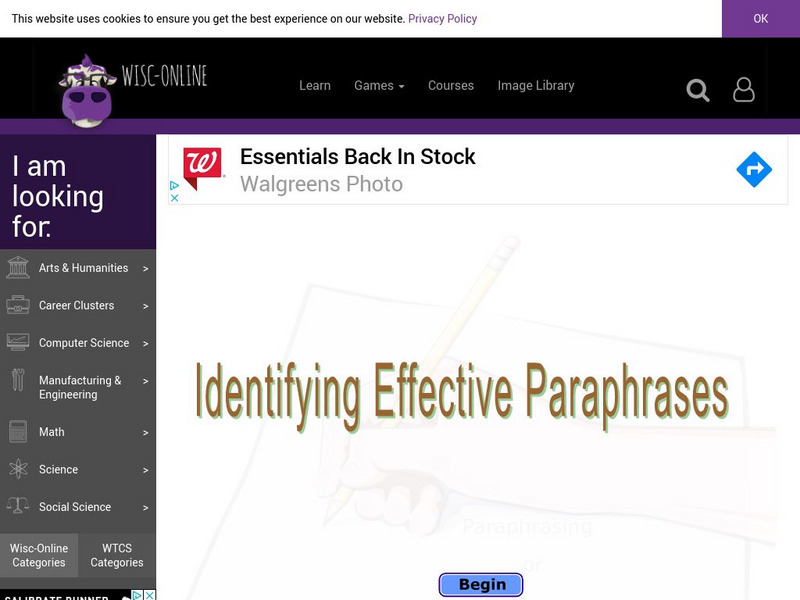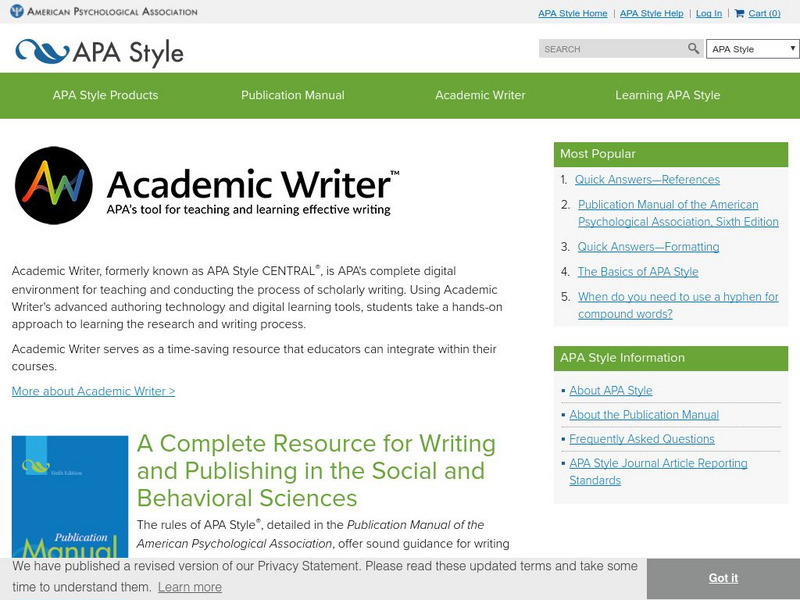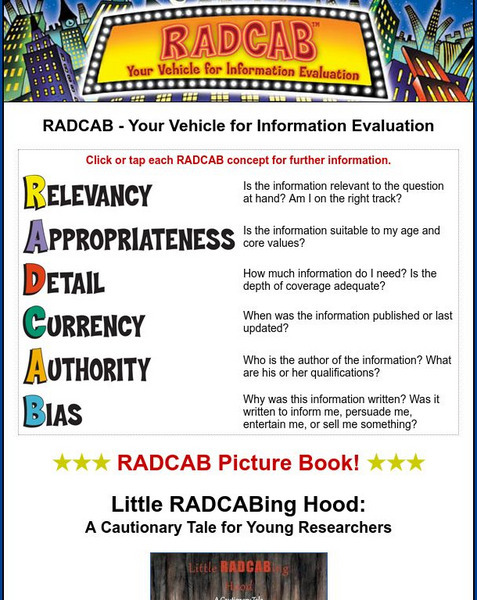TES Global
Tes: Determining of Credibility of Online Sources
[Free Registration/Login Required] This free resource is a sheet that will help students assess the credibility of an online primary source or an online secondary source.
Other
Santa Rosa Library: How to Evaluate Information Resources
Tips and information about how to evaluate resources, both print and electronic. Includes information about source authority, purpose, objectivity, currency, completeness, and relevance. It includes a printable handout (top right)with...
Sophia Learning
Sophia: In Text Citations: Lesson 6
This lesson introduces in-text citations and how to embed them in text. It is 6 of 7 in the series titled "In-Text Citations." W.9-10.8 Sources
Cambridge Rindge & Latin School
Cambridge Rindge & Latin School: Making Source Cards
A great resource for putting together all of a student's possible sources onto note cards for later using in citing.
Online Writing Lab at Purdue University
Purdue University Owl: Searching the World Wide Web: Overview
Learn to use search engines and other tools to find credible information on the Internet. Accompanying slideshow includes Internet search activities.
Cornell University
Cornell University: Library: Critically Analyzing Information Sources
A quick guide to help you determine the relevance and authority of a resource.
George Mason University
Gmu: Virginia Montecino: Criteria to Evaluate the Credibility of Www Resources
An easy-to-follow guide to assist in determining whether online resources are reliable and true. Find questions to ask while reviewing sources. CCSS.ELA-Literacy.CCRA.W.8 and CCSS.ELA-Literacy.CCRA.R.9
Online Writing Lab at Purdue University
Purdue University Owl: Evaluating Print vs. Internet Sources
Learn to look at different text features to determine whether a print or electronic source might be more effective. SL.9-10.2 eval & integrate sources
Online Writing Lab at Purdue University
Purdue University Owl: Types of Sources
A list and explanation of different types of print and online sources. W.11-12.8 Sources/Integrate/Cite
University of Toronto (Canada)
University of Toronto: Standard Documentation Formats
Documenting Internet resources is becoming standardized. You'll find some of the basics here, plus links to more detailed guidelines now included in respected academic style guides. L.9-10.3a Standard Format, W.11-12.6 Technology,...
Other
Plagiarism: Teaching About Plagiarism
The best way to prevent plagiarism is to educate students on how to properly conduct research, cite, quote, and produce unique and original work. This site offers a series of video explaining plagiarism and ways to avoid it.
University of Sydney (Australia)
The Write Site: Overview: Using Quoting & Paraphrasing
This learning module explains the components of academic writing. The module includes the following topics: original material, paraphrased content, summarized information, and direct quotations.
Indiana University
Indiana University: Plagiarism
Uses examples to explain the right and wrong way to use reference material. Shows how a rewrite can still be plagiarism. Briefly discusses common knowledge and paraphrasing.
Wisc-Online
Wisc Online: Identifying Acceptable Paraphrases
This learning module defines paraphrasing and discusses how to paraphase, and then they identify acceptable paraphrases of source material.
Department of Defense
Do Dea: The Plagiarism Spectrum
The Plagiarism Spectrum identifies 10 types of plagiarism. View this chart which tags each type with an easy to remember digital moniker, definition, rank by severity, and score by frequency of appearance.
Library of Congress
Loc: How to Cite Digitized Primary Sources
Learn from the Library of Congress how to correctly cite the many electronic resources available in their collection. Films, legal documents, photographs, maps, sound recordings and other unusual cases are covered. Be sure you click on...
Other
Apa Style Central
Use this comprehensive resource to learn about APA style. Students and teachers can use this site as a springboard for any questions they may have concerning APA Style.
Better Lesson
Better Lesson: Avoiding Plagiarism and Citing Sources
In this scaffolded lesson, students engage in practice with determining whether or not research has been plagiarized. A short video demonstration is included. [03:44] This lesson addresses all three College and Career Readiness Standards...
Wisc-Online
Wisc Online: Plagiarism
Never worry about plagiarising again! Learn from this tutorial what plagiarism is and view examples. Test yourself at the end of the slideshow to see if you can recognize plagiarism.
University of Wisconsin
University of Wisconsin: Writing Center: Quoting and Paraphrasing
This provides guidelines for creating a paraphrase, sample paraphrases, introducing quotations, punctuating, formatting quotations, and what must be documented.
University of Wisconsin
University of Wisconsin: Writing Center: Mla Documentation
This site outlines the basics of the MLA (Modern Language Association) style of documentation and includes links to handouts about in-text citations, the works cited page, and how to cite electronic sources. Several sample citations and...
University of Wisconsin
University of Wisconsin: Writing Center: Apa Documentation
This site provides information on the APA (American Psychological Association) documentation style. The information can be downloaded in PDF format. It refers to several handouts dealing with parenthetical references, reference lists,...
Other
Radcab: Your Vehicle for Information Evaluation
How do you know you are using a trustworthy source when writing a research paper? Use this acronym for easy questions to ask yourself to make sure you have a reliable source. Click on each one for further details.
Online Writing Lab at Purdue University
Purdue University Owl: Writing a Research Paper
This resource provides many links to information on writing research papers.









